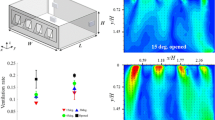Abstract
The relative freshness of indoor air in breathing zone can be measured by ventilation effectiveness. Numerous research articles in literature have investigated ventilation effectiveness under different ventilation schemes, different inlet/outlet positions, and different diffusor types. These researches seem to have a goal to find a solution to optimize ventilation effectiveness through manipulating ventilation system. In reality, however, the occupants of a rented office room have no right to manipulate the ventilation system; instead, they have to accept whatever rented to them. An important issue thus arises: how to improve ventilation effectiveness without changing ventilation system? This paper has built a CFD model about a typical office room, validated it by published experimental data in literature, and then applied it to twelve typical office situations/cases of different furniture layouts under different ventilation schemes. The simulation results of twelve cases show that furniture layout is an important factor in indoor airflow and temperature fields, and the quality of air in breathing zone can be significantly improved by adjusting furniture layout without making any change in ventilation system.
Similar content being viewed by others
References
Austin J, Brimblecombe P, Sturges W (2002). Air Pollution Science for the 21st Century. Amsterdam: Elsevier Science.
Buratti C, Mariani R, Moretti E (2011). Mean age of air in a naturally ventilated office: Experimental data and simulations. Energy and Buildings, 43: 2021–2027.
Chen Q (1995). Comparison of different k-ɛ models for indoor airflow computations. Numerical Heat Transfer, 28: 353–369.
Cheong KWD, Djunaedy E, Poh TK, Tham KW, Sekhar SC, Wong NH, Ullah MB (2003). Measurements and computations of contaminant’s distribution in an office environment. Building and Environment, 38: 135–145.
Cheong KWD, Phua SY (2006). Development of ventilation design strategy for effective removal of pollutant in the isolation room of a hospital. Building and Environment, 41: 1161–1170.
Coffey CJ, Hunt GR (2007). Ventilation effectiveness measures based on heat removal: Part 1. Definitions. Building and Environment, 42: 2241–2248.
Gee I (2001). Monitoring indoor air pollution. Indoor and Built Environment, 10: 123–124.
Halvonova B, Melikov A (2010). Performance of “ductless” personalized ventilation in conjunction with displacement ventilation: Impact of intake height. Building Environment, 45: 996–1005.
Kim KW, Kim S, Kim HJ, Park JC (2010). Formaldehyde and TVOC emission behaviors according to finishing treatment with surface materials using 20 L chamber and FLEC. Journal of Hazardous Materials, 177: 90–94.
Lau J, Chen Q (2007). Floor-supply displacement ventilation for workshops. Building and Environment, 42: 1718–1730.
Lee KS, Zhang T, Jiang Z, Chen Q (2009). Comparison of airflow and contaminant distributions in rooms with traditional displacement ventilation and under-floor air distribution systems. ASHRAE Transactions, 115(2): 306–321.
Li R, Sekhar S, Melikov A (2010). Thermal comfort and IAQ assessment of under-floor air distribution system integrated with personalized ventilation in hot and humid climate. Building Environment, 45: 1906–1913.
Li X, Li D, Yang X, Yang J (2003). Total air age: An extension of the air age concept. Building and Environment, 38: 1263–1269.
Li X, Zhao B (2004). Accessibility: A new concept to evaluate ventilation performance in a finite period of time. Indoor and Built Environment, 13:287–293.
Lin Z, Chow TT, Fong KF, Tsang CF, Wang Q (2005). Comparison of performances of displacement and mixing ventilations. Part II: Indoor air quality. International Journal of Refrigeration, 28: 288–305.
Lin Z, Jiang F, Chow TT, Tsang CF, Lu WZ (2006). CFD analysis of ventilation effectiveness in a public transport interchange. Building and Environment, 41: 254–261.
Mortensen LH, Rode C, Peuhkuri R (2008). Investigation of airflow patterns in a microclimate by particle image velocimetry (PIV). Building and Environment, 43: 1929–1938.
Pereira ML, Graudenz G, Tribess A, Morawska L (2009). Determination of particle concentration in the breathing zone for four different types of office ventilation systems. Building and Environment, 44: 904–911.
Rim D, Novoselac A (2010). Ventilation effectiveness as an indicator of occupant exposure to particles from indoor sources. Building and Environment, 45: 1214–1224.
Tian L, Lin Z, Wang Q (2010). Comparison of gaseous contaminant diffusion under stratum ventilation and under displacement ventilation. Building and Environment, 45: 2035–2046.
Xamán J, Tun J, álvarez G, Chávez Y, Noh F (2009). Optimum ventilation based on the overall ventilation effectiveness for temperature distribution in ventilated cavities. International Journal of Thermal Sciences, 48: 1574–1585.
Xing H, Hatton A, Awbi HB (2001). A study of the air quality in the breathing zone in a room with displacement ventilation. Building and Environment, 36: 809–820.
Yang W, Sohn J, Kim J, Son B, Park J (2009). Indoor air quality investigation according to age of the school buildings in Korea. Journal of Environmental Management, 90: 348–354.
Yin Y, Xu W, Gupta JK, Guity A, Marmion P, Manning A, Gulick B, Zhang X, Chen Q (2009). Experimental study on displacement and mixing ventilation systems for a patient ward. HVAC&R Research, 15: 1175–1191.
Zhang T, Lee KS, Chen Q (2009). A simplified approach to describe complex diffusers in displacement ventilation for CFD simulations. Indoor Air, 19: 255–267.
Zhang Y, Li X, Wang X, Deng W, Qian K (2006). Spatial flow influence factor: A novel concept for indoor air pollutant control. Science in China Series E-Engineering & Materials Science, 49: 115–128.
Zoon WAC, Loomans MGLC, Hensen JLM (2011). Testing the effectiveness of operating room ventilation with regard to removal of airborne bacteria. Building and Environment, 46: 2570–2577.
Author information
Authors and Affiliations
Corresponding author
Rights and permissions
About this article
Cite this article
Zhuang, R., Li, X. & Tu, J. CFD study of the effects of furniture layout on indoor air quality under typical office ventilation schemes. Build. Simul. 7, 263–275 (2014). https://doi.org/10.1007/s12273-013-0144-5
Received:
Revised:
Accepted:
Published:
Issue Date:
DOI: https://doi.org/10.1007/s12273-013-0144-5




